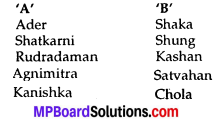MP Board Class 6th Social Science Solutions Chapter 18 The Periods of Shungas Satvahanas and Kushanas
MP Board Class 6th Social Science Chapter 18 Text Book Exercise
MP Board Class 6th Social Science Chapter 18 Very Short Answer Type Questions
Question 1.
Question (a)
Who established the Shung Dynasty?
Answer:
Pushyamhtra Shung established the Shung Dynasty in 137 B.C.
Question (b)
Who was the founder of Satavahanas?
Answer:
Simuk was the founder of Satavahanas.
![]()
Question (c)
Where did the third Boudha Sabha of Kanishka take place?
Answer:
During the time of Kanishka the third Boudha Sabha took place at ‘Kundanvan’ in Kashmir.
Question (d)
Where did the Naaga Dynasty arise?
Answer:
Naaga Dynasty arose in Vidisha, Pavaya (Padmavati Nagar), Kutwar (Kuntalpuri) and Mathura.
MP Board Class 6th Social Science Chapter 18 Short Answer Type Questions
Question 2.
Question (a)
How is the period from 200 B.C. to 300 A.D. in India treated?
Answer:
The most Mauryan period from 200 B.C. to A.D. 300 saw the rise of many states all over the Indian subcontinent. These states can be described under the following three heads:
1. States of Deccan:
On the decline of Mauryan empire many areas became independent, in the south of Vindhya mountain and the Narmada river. The best known, among them was the Satavahana family which was also known as Andhra. They ruled in the first century B.C. Satakarni was one of its great rulers. The another dynasty of this area was Shakas who ruled Surashtra and attacked Satavahana. Satayahana latter won over Shakas and regained western Deccan.
2. States of South India:
South of the Deccan plateau and south of the Satavahana kingdom, three kingdoms arose. These were the Cholas, the Pandyas and the Cheras. Sangam literature gives ample knowledge about these three states. Tanjore, Madurai and Malabar coast were the important towns of these three states. The Malabar coast and the east coast of Tamilnadu was visited by Roman ships in search of trade during this period. Besides Vedic gods and the doctrine of Buddhism and Jainism, a new religion which arose in Western Asia, called Christianity also came to India.
3. States of North India:
In the far north a number of foreigners came. They were Indo – Greeks, the Parthians, the Shakas and the Kushana.
![]()
Question (b)
What were the Dynasties of North India?
Answer:
The Dynasities of North India were Shung, Kanva, Shaka, Naaga, Kushana and Huna.
Question (c)
What were the Dynasities of South India?
Answer:
The Dynasities of South India were Satvahanas, Cholas, Chers and Pandyas.
Question (d)
Where do we get the description of ‘Sangam Sahitya’?
Answer:
Three literary councils were held in Madurai town. In the second council, two thousand poems were compiled into 8 books. These books are called the ‘Sangam Sahitya’. Sangam Sahitya is written in Tamil.
MP Board Class 6th Social Science Chapter 18 Long Answer Type Questions
Question 3.
Question (a)
Give details about the art during 300 B.C. to 200 A.D?
Answer:
1. Mathura School of Art:
The Mathura School of Art flourished in the early centuries of the Christian era. It was an indigenous art. Mathura produced beautiful images of the Buddha. Its products made of red sand stone are found even outside Mathura.
2. Gandhara School of Art:
The Gandhara School of Art flourished in the region of Kanishka. The style of Gandharva art was developed by the Indian artists in the province of Gandhara. It was the result of contacts between Indian artists and the Greeks and the Roman artists. In this style the images of the Buddha were made. This art was popular not only in Punjab and Kashmir but in modern Afghanistan also.
3. Similarity:
Both the schools of art were different in style but they were similar in the fact that both of them made image of the Buddha.
![]()
Question 4.
Fill in the blanks:
- The famous king of Shaka was ……………..
- The last ruler of Mauryan Dynasty was ……………….
- At …………………… Kanishka held the third Boudha Mahasabha.
- ……………….. was the founder of the Satvahana dynasty.
Answer:
- Rudradaman
- Brahdrath
- Kundanvan
- Simuk
Question 5.
Match the following:

Answer:
